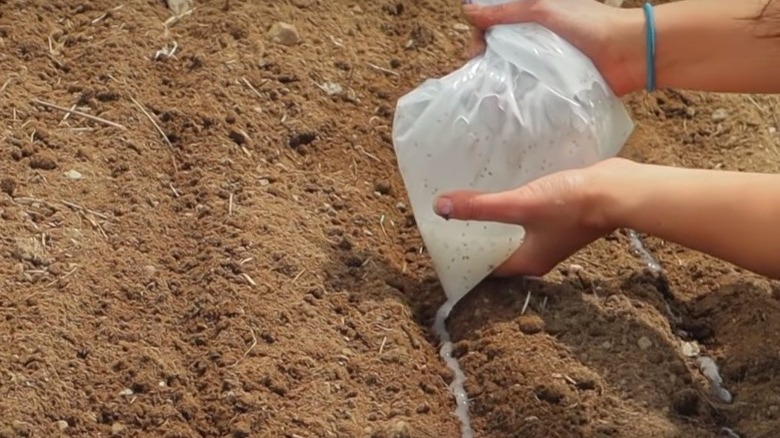The Cornstarch Hack That Makes Planting Seeds Easier And Faster
There's nothing like the satisfaction of growing a beautiful plant from seed. Unfortunately, it doesn't always go as planned; without the right growing conditions, your seedlings may die, become leggy, or fail to germinate in the first place. One common issue is overcrowding, which forces plants to compete for sunlight and nutrients. Gardeners often have to thin out seedlings to give the others a better chance at thriving, but this can feel like a waste of seeds. One common kitchen ingredient you already have can be used instead: cornstarch. Use cornstarch to create a DIY seed tape or gel for perfectly spaced seeds.
With seed tape, seeds are placed on biodegradable paper at the ideal spacing, so you can simply place the tape in the soil rather than measuring each row or planting one seed at a time. This method eliminates the risks of overcrowding, reduces seed waste, and saves you from having to thin plants later. It also makes it easier to work with tiny seeds, such as carrots and protects them from wildlife and heavy rains. Seeding gel works in a similar way but without the paper, so the spacing is less uniform. The idea of using cornstarch to transform your garden might seem strange at first, but cornstarch is a natural binding ingredient perfect for making your own seed tape or gel for almost no money. For biodegradable paper (the base of the seed tape), you can use organic, unbleached toilet paper or paper towels.
How to make DIY seed tape with cornstarch
Although there is more than one method to create a DIY seed tape, for cornstarch paste, you'll start by combining 1 cup of water and 1 tablespoon of cornstarch. Then, bring the mixture to a boil for 5 minutes until it thickens into a gel consistency. Let the paste cool completely, then dab it onto strips of your biodegradable paper. These dabs are where you'll place your seeds, so space them out accordingly. Press a seed into each dot of cornstarch paste, fold the paper over to seal them in place, and let the seed tape dry completely before handling. When it's time to plant, simply position the tape into your prepped rows and cover it with soil and water.
DIY seed tape isn't every gardener's method of choice, especially since you can only use it for seeds that you sow directly into the ground rather than starting indoors. Keep in mind that some papers take longer to dissolve in soil than others; if the paper is too slow to break down, your seeds may not start growing when you hoped. Depending on how many seeds you're planting and how easy it is for you to bend over, it may be less time-consuming to sow by hand; just sow as precisely as you can to avoid overcrowding, or try using a plain cornstarch gel for seeding instead.
Cornstarch gel makes sowing easy
This cornstarch planting hack, also known as "fluid seeding," works a bit differently than seed tape. The techniques share the benefit of preventing overcrowding, but with this one, there's no paper to keep the seeds neatly in place, so the results are less uniform. On the other hand, it's less time-consuming and still easier than sowing completely by hand. No paper means no risk of it not dissolving in time, and the seeds also benefit from the extra moisture in the gel.
The initial process is similar: combine 1 cup of water and 1 tablespoon of cornstarch on the stove and bring it to a boil for 5 minutes until it thickens. After it cools, pour the mixture into a resealable bag and place the seeds directly in; they should be suspended in the gel rather than falling to the bottom. When your rows are ready, cut a hole into the corner of the bag and squeeze the gel into them. You can reduce the spacing between seeds by adding more seeds to the bag or create more spacing by adding more gel to the bag. You can also adjust the size of the hole to change how quickly the gel flows — so start small. It may take a bit of trial and error to get the perfect consistency and spacing, but once the gel is laid in neat garden rows, all that's left to do is cover them with soil.


